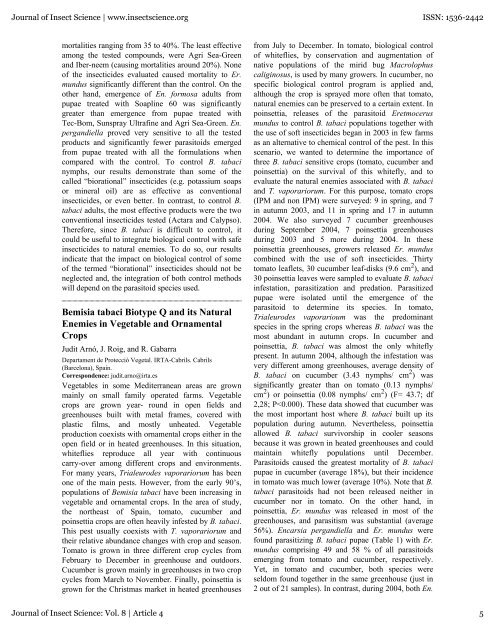Fourth International Bemisia Workshop International Whitefly ...
Fourth International Bemisia Workshop International Whitefly ...
Fourth International Bemisia Workshop International Whitefly ...
You also want an ePaper? Increase the reach of your titles
YUMPU automatically turns print PDFs into web optimized ePapers that Google loves.
Journal of Insect Science | www.insectscience.org ISSN: 1536-2442<br />
mortalities ranging from 35 to 40%. The least effective<br />
among the tested compounds, were Agri Sea-Green<br />
and Iber-neem (causing mortalities around 20%). None<br />
of the insecticides evaluated caused mortality to Er.<br />
mundus significantly different than the control. On the<br />
other hand, emergence of En. formosa adults from<br />
pupae treated with Soapline 60 was significantly<br />
greater than emergence from pupae treated with<br />
Tec-Bom, Sunspray Ultrafine and Agri Sea-Green. En.<br />
pergandiella proved very sensitive to all the tested<br />
products and significantly fewer parasitoids emerged<br />
from pupae treated with all the formulations when<br />
compared with the control. To control B. tabaci<br />
nymphs, our results demonstrate than some of the<br />
called “biorational” insecticides (e.g. potassium soaps<br />
or mineral oil) are as effective as conventional<br />
insecticides, or even better. In contrast, to control B.<br />
tabaci adults, the most effective products were the two<br />
conventional insecticides tested (Actara and Calypso).<br />
Therefore, since B. tabaci is difficult to control, it<br />
could be useful to integrate biological control with safe<br />
insecticides to natural enemies. To do so, our results<br />
indicate that the impact on biological control of some<br />
of the termed “biorational” insecticides should not be<br />
neglected and, the integration of both control methods<br />
will depend on the parasitoid species used.<br />
<strong>Bemisia</strong> tabaci Biotype Q and its Natural<br />
Enemies in Vegetable and Ornamental<br />
Crops<br />
Judit Arnó, J. Roig, and R. Gabarra<br />
Departament de Protecció Vegetal. IRTA-Cabrils. Cabrils<br />
(Barcelona), Spain.<br />
Correspondence: judit.arno@irta.es<br />
Vegetables in some Mediterranean areas are grown<br />
mainly on small family operated farms. Vegetable<br />
crops are grown year- round in open fields and<br />
greenhouses built with metal frames, covered with<br />
plastic films, and mostly unheated. Vegetable<br />
production coexists with ornamental crops either in the<br />
open field or in heated greenhouses. In this situation,<br />
whiteflies reproduce all year with continuous<br />
carry-over among different crops and environments.<br />
For many years, Trialeurodes vaporariorum has been<br />
one of the main pests. However, from the early 90’s,<br />
populations of <strong>Bemisia</strong> tabaci have been increasing in<br />
vegetable and ornamental crops. In the area of study,<br />
the northeast of Spain, tomato, cucumber and<br />
poinsettia crops are often heavily infested by B. tabaci.<br />
This pest usually coexists with T. vaporariorum and<br />
their relative abundance changes with crop and season.<br />
Tomato is grown in three different crop cycles from<br />
February to December in greenhouse and outdoors.<br />
Cucumber is grown mainly in greenhouses in two crop<br />
cycles from March to November. Finally, poinsettia is<br />
grown for the Christmas market in heated greenhouses<br />
from July to December. In tomato, biological control<br />
of whiteflies, by conservation and augmentation of<br />
native populations of the mirid bug Macrolophus<br />
caliginosus, is used by many growers. In cucumber, no<br />
specific biological control program is applied and,<br />
although the crop is sprayed more often that tomato,<br />
natural enemies can be preserved to a certain extent. In<br />
poinsettia, releases of the parasitoid Eretmocerus<br />
mundus to control B. tabaci populations together with<br />
the use of soft insecticides began in 2003 in few farms<br />
as an alternative to chemical control of the pest. In this<br />
scenario, we wanted to determine the importance of<br />
three B. tabaci sensitive crops (tomato, cucumber and<br />
poinsettia) on the survival of this whitefly, and to<br />
evaluate the natural enemies associated with B. tabaci<br />
and T. vaporariorum. For this purpose, tomato crops<br />
(IPM and non IPM) were surveyed: 9 in spring, and 7<br />
in autumn 2003, and 11 in spring and 17 in autumn<br />
2004. We also surveyed 7 cucumber greenhouses<br />
during September 2004, 7 poinsettia greenhouses<br />
during 2003 and 5 more during 2004. In these<br />
poinsettia greenhouses, growers released Er. mundus<br />
combined with the use of soft insecticides. Thirty<br />
tomato leaflets, 30 cucumber leaf-disks (9.6 cm 2 ), and<br />
30 poinsettia leaves were sampled to evaluate B. tabaci<br />
infestation, parasitization and predation. Parasitized<br />
pupae were isolated until the emergence of the<br />
parasitoid to determine its species. In tomato,<br />
Trialeurodes vaporarioum was the predominant<br />
species in the spring crops whereas B. tabaci was the<br />
most abundant in autumn crops. In cucumber and<br />
poinsettia, B. tabaci was almost the only whitefly<br />
present. In autumn 2004, although the infestation was<br />
very different among greenhouses, average density of<br />
B. tabaci on cucumber (3.43 nymphs/ cm 2 ) was<br />
significantly greater than on tomato (0.13 nymphs/<br />
cm 2 ) or poinsettia (0.08 nymphs/ cm 2 ) (F= 43.7; df<br />
2,28; P
















